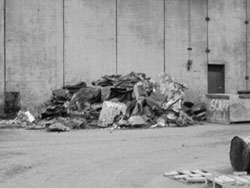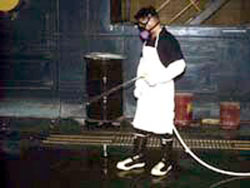Lead: Secondary Lead Smelter eTool
Raw Materials Processing » Charge Preparation/Drying
Charge preparation is the process of blending the stored lead scrap and the lead from batteries to the proper metallurgical requirements so it can be charged to the furnace.
Before raw material can be charged to a reverberatory furnace, it must be dried to zero percent moisture. When the reverberatory furnace is charged with feed of consistent moisture content, upset conditions (puffs and explosions) are reduced.
Hazards exist during the charge preparation/drying phase that may expose workers to lead-bearing dusts.
Note: Drying is not done by all secondary lead smelters prior to the smelting operation.

Potential Sources of Exposure
-
Lead dust may be reentrained from the road or floor as vehicles move about the charge prep area. (Fig. 1).
-
Lead dust may become airborne during the transport and mixing of lead bearing materials when using mobile equipment.
-
Dust may be generated at conveyor loading or transfer points during charge prep.
Possible Engineering and Work Practice Controls
- Provide vehicles with enclosed cabs that have positive pressure, HEPA-filtered air.
- Keep all surfaces wet and clean through the use of water supply systems and central vacuum cleaners.
-
Provide ventilated enclosures for mixing feed materials.
-
Maintain positive-pressure, filtered air systems on mobile equipment to ensure effective operation. Check and change air filters regularly as part of an effective scheduled preventative maintenance program.
-
Remain inside the vehicle and keep doors and windows shut during mobile equipment operation in contaminated areas.
-
Reduce vehicle speeds to minimize the reentrainment of settled dust.
-
Vacuum the inside of mobile equipment frequently.
-

Pave all surfaces to facilitate housekeeping.
-
Wet down materials and surfaces to suppress dust generation. (Fig. 2).
-
If it is determined that lead dust is coming from mobile equipment or is being blown from adjacent areas, evaluate material handling patterns and area isolation.
-
Refer to Feed Material Handling and Transport for possible conveyor transport controls.
The dryer is a rotating vessel, usually gas fired, where the charge material is added at one end and travels the length of the dryer, then discharged on the other end onto a belt conveyor and discharged to the furnace.
Potential Sources of Exposure
- Lead dust may be generated:
-
At the discharge end of dryers.
-
At the transfer points to the ram feeder or reverberatory furnace.
-
-
The dryer may leak lead-bearing dust due to inadequate exhaust ventilation.
-
Fugitive emissions may come from charge preparation.
-
Lead dust may be reentrained from the road or floor as vehicles move about the drying area.
-
Lead dust may become airborne during the transport and loading of lead bearing materials when using mobile equipment.
Possible Engineering and Work Practice Controls
-
Use process controls to prevent dryer operation without adequate exhaust ventilation.
-
Provide local exhaust ventilation at the discharge end of the dryer.
-
Provide local exhaust ventilation at the reverberatory furnace charge hole.
-
Develop a written schedule of inspections and audit checklist for dryer operators.
-
Cleanup surfaces of equipment and floors during every shift, vacuuming whenever possible.
-
Maintain positive-pressure, filtered-air system on mobile equipment to ensure effective operation. Check and change air filters regularly as part of an effective scheduled preventative maintenance program.
-
Remain inside the vehicle and keep doors and windows shut during mobile equipment operation in contaminated areas.
-
Reduce vehicle speeds to minimize the reentrainment of settled dust.
-
Vacuum the inside of mobile equipment frequently.

